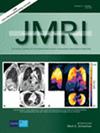Magnetic Resonance Elastography of Anterior Mediastinal Tumors
Abstract
Background
Preoperative differentiation of the types of mediastinal tumors is essential. Magnetic resonance (MR) elastography potentially provides a noninvasive method to assess the classification of mediastinal tumor subtypes.
Purpose
To evaluate the use of MR elastography in anterior mediastinal masses and to characterize the mechanical properties of tumors of different subtypes.
Study Type
Prospective.
Subjects
189 patients with anterior mediastinal tumors (AMTs) confirmed by histopathology (62 thymomas, 53 thymic carcinomas, 57 lymphomas, and 17 germ cell tumors).
Field Strength/Sequence
A gradient echo-based 2D MR elastography sequence and a diffusion-weighted imaging (DWI) sequence at 3.0 T.
Assessment
Stiffness and apparent diffusion coefficients (ADC) were measured in AMTs using MR elastography-derived elastograms and DWI-derived ADC maps, respectively. The aim of this study is to identify whether MR elastography can differentiate between the histological subtypes of ATMs.
Statistical Tests
One-way analysis of variance (ANOVA), two-way ANOVA, Pearson's linear correlation coefficient (r), receiver operating characteristic (ROC) curve analysis; P < 0.05 was considered significant.
Results
Lymphomas had significantly lower stiffness than other AMTs (4.0 ± 0.63 kPa vs. 4.8 ± 1.39 kPa). The mean stiffness of thymic carcinomas was significantly higher than that of other AMTs (5.6 ± 1.41 kPa vs. 4.2 ± 0.94 kPa). Using a cutoff value of 5.0 kPa, ROC analysis showed that lymphomas could be differentiated from other AMTs with an accuracy of 59%, sensitivity of 97%, and specificity of 38%. Using a cutoff value of 5.1 kPa, thymic carcinomas could be differentiated from other AMTs with an accuracy of 84%, sensitivity of 67%, and specificity of 90%. However, there was an overlap in the stiffness values of individual thymomas (4.2 ± 0.71; 3.9–4.5), thymic carcinomas (5.6 ± 1.41; 5.0–6.1), lymphomas (4.0 ± 0.63; 3.8–4.2), and germ cell tumors (4.5 ± 1.79; 3.3–5.6).
Data Conclusion
MR elastography-derived stiffness may be used to evaluate AMTs of various histologies.
Level of Evidence
4.
Technical Efficacy
Stage 2.


 求助内容:
求助内容: 应助结果提醒方式:
应助结果提醒方式:


